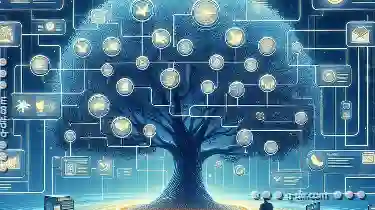One such component that has seen significant changes over time is the tree view. This blog post will explore whether tree views are relics of a bygone era ...
 in information architecture or if they still hold relevance in contemporary UI design. We'll break down the topic into several sub-points, examining their historical context, modern usage, advantages, and potential future directions. In today's rapidly evolving digital landscape, user interface (UI) design principles continue to advance.
in information architecture or if they still hold relevance in contemporary UI design. We'll break down the topic into several sub-points, examining their historical context, modern usage, advantages, and potential future directions. In today's rapidly evolving digital landscape, user interface (UI) design principles continue to advance.1. Understanding Tree Views: A Brief History
2. Modern Use of Tree Views
3. Advantages of Tree Views in Modern Interfaces
4. Critiques of Tree Views
5. Future Directions for Tree Views in UI Design
6. Conclusion: A Balancing Act Between Tradition and Innovation
1.) Understanding Tree Views: A Brief History
1. The Origins of Tree Views
Tree views first emerged in graphical user interfaces (GUIs) as a way to represent hierarchical data structures, typically used for file systems or organizational charts. These visual aids help users navigate complex information by presenting nodes that branch out like the limbs of a tree.
2. Evolution Over Time
As technology progressed and software applications became more sophisticated, tree views were adapted and modified to suit various needs. Initially rigid in design, they evolved into customizable components that could accommodate different types of data structures and user interactions.
2.) Modern Use of Tree Views
1. Current Trends in UI Design
In today's minimalist and intuitive interface designs, the role of tree views has shifted. While they are still used for hierarchical navigation, modern interfaces often incorporate them into more streamlined layouts that balance information density with usability.
2. Integration with Other UI Elements
Many contemporary applications integrate tree views with other interactive elements like expandable panels and filters, enhancing user control over the data presentation without overwhelming the interface.
3.) Advantages of Tree Views in Modern Interfaces
1. Hierarchical Clarity
Tree views offer a clear visual representation of relationships between different nodes or items, making it easier for users to understand at-a-glance how various elements are organized and connected.
2. Efficient Data Manipulation
With features like drag-and-drop functionality, tree views allow users to rearrange data easily within the hierarchy, which is particularly useful in collaborative environments where permissions or content structuring need frequent adjustments.
4.) Critiques of Tree Views
1. Space Intrusion
Some critics argue that traditional tree views can intrude on a user interface, especially when dealing with large amounts of information. Modern interfaces aim to minimize visual clutter and maximize real estate for displaying data without unnecessary elements like hierarchical trees.
2. Learning Curve
For users not accustomed to the hierarchical structure implied by tree views, navigating through them might require more mental effort compared to flatter, linear navigation schemes. This could potentially affect user experience negatively depending on their level of technical expertise or digital literacy.
5.) Future Directions for Tree Views in UI Design
1. Progressive Enhancement
To mitigate issues with large data sets and complex structures, future tree views might integrate features like lazy loading where nodes are only expanded when necessary, reducing the initial load time and improving performance across devices.
2. Adaptive Interfaces
As mobile and desktop interfaces continue to converge, tree views may adapt dynamically based on screen size or device type, providing a more tailored user experience that is both efficient and engaging.
6.) Conclusion: A Balancing Act Between Tradition and Innovation
While some might view tree views as remnants of an outdated era in UI design, their continued relevance can be attributed to the flexibility they provide in managing hierarchical data. The key lies in how these components are integrated into contemporary interfaces-as tools that enhance usability without overwhelming the user experience or cluttering the interface with unnecessary complexity.
In conclusion, while tree views might not represent the pinnacle of modern UI design, their ability to adapt and evolve alongside digital trends makes them valuable elements for designers looking to balance tradition with innovation in navigation components.

The Autor: / 0 2025-02-19
Read also!
Page-

Cutting Files from Encrypted Drives: What You Must Know
Encryption is a fundamental technology used in modern computing to secure data, ensuring that only authorized users can access it. It involves ...read more
Icon View: A Crutch, Not a Catalyst, for Digital Mastery
Among these interfaces, icon views have long been a staple feature in various software applications, from operating systems to productivity tools. ...read more

The Great Folder Permission Crisis: Who Really Owns Your Data?
However, amidst the convenience and efficiency it offers, there lies a significant issue that affects both amateur users and tech-savvy individuals ...read more